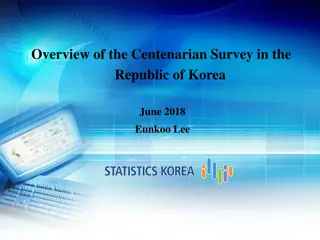Measuring Divine Control in South Korea
A study on the prevalent belief in divine control in South Korea, its impact on mental health, and the importance of incorporating cultural nuances into the measurement process. Suggestions for refining the measure and exploring the perception of shared responsibility with a higher power are also discussed.
Download Presentation

Please find below an Image/Link to download the presentation.
The content on the website is provided AS IS for your information and personal use only. It may not be sold, licensed, or shared on other websites without obtaining consent from the author.If you encounter any issues during the download, it is possible that the publisher has removed the file from their server.
You are allowed to download the files provided on this website for personal or commercial use, subject to the condition that they are used lawfully. All files are the property of their respective owners.
The content on the website is provided AS IS for your information and personal use only. It may not be sold, licensed, or shared on other websites without obtaining consent from the author.
E N D
Presentation Transcript
MATH Introduction Math Selected Themes Assessment targets Progress Map LEARNING PROGRESSION
4 BUILDING BLOCKS Learning Progression Item Design Assessment Quality Outcomes/ Scoring
INTRODUCTION Bear Assessment System Stage 1 Focus on the process of learning and on individual student s progress through that process Progress maps At a grade level, a learning progression map can represent one content standard/cluster within which standards are ranked in the order of cognitive complexity Across grade levels, a learning progression map represent several related content standards/clusters each of which standards are ranked in the order of cognitive complexity
HOW TO READ MATH STANDARDS Grade Level 8.EE Expressions and Equations Domain 8.EE.8 Analyze and solve linear equations and pairs of simultaneous linear equations. Understand that solutions to a system of two linear equations in two variables correspond to points of intersection of their graphs, because points of intersection satisfy both equations simultaneously. Solve systems of two linear equations in two variables algebraically, and estimate solutions by graphing the equations. Solve simple cases by inspection. For example, 3x + 2y = 5 and 3x + 2y = 6 have no solution because 3x + 2y cannot simultaneously be 5 and 6. Solve real-world and mathematical problems leading to two linear equations in two variables. For example, given coordinates for two pairs of points, determine whether the line through the first pair of points intersects the line through the second pair. a. Content standard (Cluster, containing a, b, c) b. Standard (8.EE.8.c) c.
MATH SELECTED THEME Selected Theme: Problem-solving (Claim #2) Rationale: Applies across all mathematics topics Addresses mathematical practice Allows for posing of non-traditional problem types
A GLIMPSE AT THE WHOLE LP! We ll be looking at an example from this portion, upper elementary to middle school
EXAMPLE LP (UPPER ELEMENTARY AND MIDDLE SCHOOL; ALGEBRAIC PROBLEM SOLVING) Grade Grade 8 SBAT SBAT Specific Specific Common Core Standards Common Core Standards 8.EE.B 8.EE.C Understand the connections between proportional relationships, lines, and linear equations (8.EE.5 8.EE.6). Analyze and solve linear equations and pairs of simultaneous linear equations (8.EE.7 8.EE.8c). Work with radicals and integer exponents (8.EE.1 8.EE.4). 7 7.EE.A 7.EE.B Use properties of operations to generate equivalent expressions. Use properties of operations to generate equivalent expressions (7.EE.1 7.EE.2). Solve real-life and mathematical problems using numerical and algebraic expressions and equations (7.EE.3 7.EE.4b). 6 6.EE.A 6.EE.B 6.EE.C Apply and extend previous understandings of arithmetic to algebraic expressions (6.EE.1 6.EE.4). Reason about and solve one-variable equations and inequalities (6.EE.5 6.EE.8). Represent and analyze quantitative relationships between dependent and independent variables (6.EE.9).
EXAMPLE LP (UPPER ELEMENTARY AND MIDDLE SCHOOL; ALGEBRAIC PROBLEM SOLVING) Grade Grade 5 SBAT SBAT Specific Specific Common Core Standards Common Core Standards - Write and interpret numerical expressions (5.OA.1 5.OA.2). Analyze patterns and relationships (5.OA.3). 4.OA.A Use the four operations with whole numbers to solve problems (4.OA.1 4.OA.3). Gain familiarity with factors and multiples (4.OA.4). Generate and analyze patterns (4.OA.5). 4 Notes: OA = Operation and Algebraic Thinking domain EE = Expressions and Equations domain SBAT = Smarter Balanced Assessment Targets as required to achieve Claim #2
EXAMPLE LP (UPPER ELEMENTARY AND MIDDLE SCHOOL; ALGEBRAIC PROBLEM SOLVING) Grade Grade 6 SBAT SBAT 6.EE.A 6.EE.B 6.EE.C Specific Specific Common Core Standards Common Core Standards Apply and extend previous understandings of arithmetic to algebraic expressions (6.EE.1 6.EE.4). Reason about and solve one-variable equations and inequalities (6.EE.5 6.EE.8). Represent and analyze quantitative relationships between dependent and independent variables (6.EE.9). Write and interpret numerical expressions (5.OA.1 5.OA.2). Analyze patterns and relationships (5.OA.3). 5 -
EXAMPLE LP (UPPER ELEMENTARY AND MIDDLE SCHOOL; ALGEBRAIC PROBLEM SOLVING) Grade Grade 7 and 7 and 6 6 7 SBAT SBAT Specific Specific Common Core Standards Common Core Standards 7.EE.A 7.EE.B Use properties of operations to generate equivalent expressions. Use properties of operations to generate equivalent expressions (7.EE.1 7.EE.2). Solve real-life and mathematical problems using numerical and algebraic expressions and equations (7.EE.3 7.EE.4b). Apply and extend previous understandings of arithmetic to algebraic expressions (6.EE.1 6.EE.4). Reason about and solve one-variable equations and inequalities (6.EE.5 6.EE.8). Represent and analyze quantitative relationships between dependent and independent variables (6.EE.9). 6 6.EE.A 6.EE.B 6.EE.C
EXAMPLE LP (UPPER ELEMENTARY AND MIDDLE SCHOOL; ALGEBRAIC PROBLEM SOLVING) Grade Grade 8 SBAT SBAT 8.EE.B 8.EE.C Specific Specific Common Core Standards Common Core Standards Work with radicals and integer exponents (8.EE.1 8.EE.4). Understand the connections between proportional relationships, lines, and linear equations (8.EE.5 8.EE.6). Analyze and solve linear equations and pairs of simultaneous linear equations (8.EE.7 8.EE.8c). Use properties of operations to generate equivalent expressions. Use properties of operations to generate equivalent expressions (7.EE.1 7.EE.2). Solve real-life and mathematical problems using numerical and algebraic expressions and equations (7.EE.3 7.EE.4b). 7 7.EE.A 7.EE.B
ASSESSMENT TARGETS In SBAC, each claim has specific assessment targets Assessment targets for Claim #2 on problem solving: A = Apply Apply mathematics to solve well-posed problems in pure mathematics and those arising in everyday life, society, and the workplace (DOK 2, 3) B = Select Select and use use appropriate tools strategically. (DOK 1, 2) C = Interpret Interpret results in the context of a situation. (DOK 2) D = Identify Identify important quantities in a practical situation and map their relationships (e.g., using diagrams, two-way tables, graphs, flowcharts, or formulas).(DOK 1, 2, 3) map DOK Depth of Knowledge as listed in the Cognitive Rigor Matrix (SBAC, 2012). Numbers represent level.
BIBLIOGRAPHY Common Core Standards Initiative. (2014). Common core standards for mathematics. Retrieved from http://www.corestandards.org/Math/ Common Core Standards Initiative. (2014). Common core standards for English language arts & literacy in history/social studies, science, and technical subjects. Retrieved from http://www.corestandards.org/ELA-Literacy/ Hess, K., Carloc, D., Jones, B., & Walkup, J., (2009). What exactly do fewer, clearer, and higher standards really look like in the classroom? Using a cognitive rigor matrix to analyze curriculum, plan lessons, and implement assessments. Paper presented at CCSSO, Detroit, Michigan. Oregon Department of Education. (2014, June). Assessment guidance. Webb, N. (2007). Aligning assessments and standards. Retrieved from http://www.wcer.wisc.edu/news/coverStories/aligning_assessments_and_standards.p hp Wilson, M. (2005). Constructing measures: An item response modeling approach. New York: Psychology Press, Taylor & Francis Group. Wilson, M., & Sloane, K. (2000). From principles to practice: An embedded assessment system. Applied Measurement in Education, 13 (2), pp. 181-208. Smarter Balanced Assessment Consortium. (2012, April). General item specifications. Smarter Balanced Assessment Consortium. (2013, June). Content specifications for the summative assessment of the Common Core State Standards for Mathematics. Revised draft.
CREATIVE COMMONS LICENSE Introduction to Learning Progressions (Math) PPT by the Oregon Department of Education and Berkeley Evaluation and Assessment Research Center is licensed under a CC BY 4.0. You are free to: You are free to: Share Share copy and redistribute the material in any medium or format Adapt Adapt remix, transform, and build upon the material Under the following terms: Under the following terms: Attribution Attribution You must give appropriate credit, provide a link to the license, and indicate if changes were made. You may do so in any reasonable manner, but not in any way that suggests the licensor endorses you or your use. NonCommercial NonCommercial You may not use the material for commercial purposes. ShareAlike ShareAlike If you remix, transform, or build upon the material, you must distribute your contributions under the same license as the original. Oregon Department of Education welcomes editing of these resources and would greatly appreciate being able to learn from the changes made. To share an edited version of this resource, please contact Cristen McLean, cristen.mclean@state.or.us.

 undefined
undefined

























